Trans-Siberian Railway
The Trans-Siberian Railway (TSR; Russian: Транссибирская магистраль, Transsibirskaya Magistral', [trəns.sʲɪˈbʲirskəjə məɡʲɪˈstralʲ]) connects European Russia to the Russian Far East.[1] Spanning a length of over 9,289 kilometres (5,772 miles), it is the longest railway line in the world.[2] It runs from the city of Moscow in the west to the city of Vladivostok in the east.
| Trans-Siberian Railway | |||||||||||||||||||||||||||||||||||||||||||||||||||||||||||||||||||||||||||||||||||||||||||||||||||||||||||||||||||||||||||||||||||||||||||||||||||||||||||||||||||||||||||||||||||||||||||||||||||||||||||||||||||||||||||||||||||||||||||||||||||||||||||||||||||||||||||||||||||||||||||||||||||||||||||||||||||||||||||||||||||||||||||||||||||||||||||||||||||||||||||||||||||||||||||||||||||||||||||||||||||||||||||||||||||||||||||||||||||||||||||||||||||||||||||||||||||||||||||||||||||||||||||||||||||||||||||||||||||||||||||||||||||||||||||||||||||||||||||||||||||||||||||||||||||||||||||||||||||||||||||||||||||||||||||||||||||||||||||||||||||||||||||||||||||||||||||||||||||||||||||||||||||||||||||||||||||||||||||||||||||||||||||||||||||||||||||||||||||||||||||||||||||||||||||||||||||||||||||||||||||||||||||||||||||||||||||||||||||||||||||||||||||||||||||||||||||||||||||||||||||||||||||||||||||||||||||||||||||||||||||||||||||||||||||||||||||||||||||||||||||||||||||||||||||||||||||||||||||||||
|---|---|---|---|---|---|---|---|---|---|---|---|---|---|---|---|---|---|---|---|---|---|---|---|---|---|---|---|---|---|---|---|---|---|---|---|---|---|---|---|---|---|---|---|---|---|---|---|---|---|---|---|---|---|---|---|---|---|---|---|---|---|---|---|---|---|---|---|---|---|---|---|---|---|---|---|---|---|---|---|---|---|---|---|---|---|---|---|---|---|---|---|---|---|---|---|---|---|---|---|---|---|---|---|---|---|---|---|---|---|---|---|---|---|---|---|---|---|---|---|---|---|---|---|---|---|---|---|---|---|---|---|---|---|---|---|---|---|---|---|---|---|---|---|---|---|---|---|---|---|---|---|---|---|---|---|---|---|---|---|---|---|---|---|---|---|---|---|---|---|---|---|---|---|---|---|---|---|---|---|---|---|---|---|---|---|---|---|---|---|---|---|---|---|---|---|---|---|---|---|---|---|---|---|---|---|---|---|---|---|---|---|---|---|---|---|---|---|---|---|---|---|---|---|---|---|---|---|---|---|---|---|---|---|---|---|---|---|---|---|---|---|---|---|---|---|---|---|---|---|---|---|---|---|---|---|---|---|---|---|---|---|---|---|---|---|---|---|---|---|---|---|---|---|---|---|---|---|---|---|---|---|---|---|---|---|---|---|---|---|---|---|---|---|---|---|---|---|---|---|---|---|---|---|---|---|---|---|---|---|---|---|---|---|---|---|---|---|---|---|---|---|---|---|---|---|---|---|---|---|---|---|---|---|---|---|---|---|---|---|---|---|---|---|---|---|---|---|---|---|---|---|---|---|---|---|---|---|---|---|---|---|---|---|---|---|---|---|---|---|---|---|---|---|---|---|---|---|---|---|---|---|---|---|---|---|---|---|---|---|---|---|---|---|---|---|---|---|---|---|---|---|---|---|---|---|---|---|---|---|---|---|---|---|---|---|---|---|---|---|---|---|---|---|---|---|---|---|---|---|---|---|---|---|---|---|---|---|---|---|---|---|---|---|---|---|---|---|---|---|---|---|---|---|---|---|---|---|---|---|---|---|---|---|---|---|---|---|---|---|---|---|---|---|---|---|---|---|---|---|---|---|---|---|---|---|---|---|---|---|---|---|---|---|---|---|---|---|---|---|---|---|---|---|---|---|---|---|---|---|---|---|---|---|---|---|---|---|---|---|---|---|---|---|---|---|---|---|---|---|---|---|---|---|---|---|---|---|---|---|---|---|---|---|---|---|---|---|---|---|---|---|---|---|---|---|---|---|---|---|---|---|---|---|---|---|---|---|---|---|---|---|---|---|---|---|---|---|---|---|---|---|---|---|---|---|---|---|---|---|---|---|---|---|---|---|---|---|---|---|---|---|---|---|---|---|---|---|---|---|---|---|---|---|---|---|---|---|---|---|---|---|---|---|---|---|---|---|---|---|---|---|---|---|---|---|---|---|---|---|---|---|---|---|---|---|---|---|---|---|---|---|---|---|---|---|---|---|---|---|---|---|---|---|---|---|---|---|---|---|---|---|---|---|---|---|---|---|---|---|---|---|---|---|---|---|---|---|---|---|---|---|---|---|---|---|---|---|---|---|---|---|---|---|---|---|---|---|---|---|---|---|---|---|---|---|---|---|---|---|---|---|---|---|---|---|---|---|---|---|---|---|---|---|---|---|---|---|---|---|---|---|---|---|---|---|---|---|---|---|---|---|---|---|---|---|---|---|---|---|---|---|---|---|---|---|---|---|---|---|---|---|---|---|---|---|---|---|---|---|---|---|---|---|---|---|---|---|---|---|---|---|---|---|---|---|---|---|---|---|---|---|---|---|---|---|---|---|---|---|---|---|---|---|---|---|---|---|---|---|---|---|---|---|---|---|---|---|---|---|---|---|---|---|---|---|---|---|---|---|---|---|---|---|---|---|---|---|---|---|---|---|---|---|---|---|---|---|---|---|---|---|---|---|---|---|---|---|---|---|---|---|---|---|---|---|---|---|---|---|---|---|---|---|---|---|---|---|---|---|---|---|---|---|---|---|---|---|---|---|---|---|---|---|---|---|---|---|---|---|---|---|---|---|---|---|---|---|---|---|---|---|---|---|---|---|---|---|---|---|---|---|---|---|---|---|---|---|---|---|---|---|---|---|---|---|---|---|---|---|---|---|---|---|---|---|---|---|---|---|---|---|---|---|---|---|---|---|---|---|---|---|---|---|---|---|---|---|---|---|---|---|---|---|---|---|---|---|---|---|---|---|---|---|---|---|---|---|---|---|
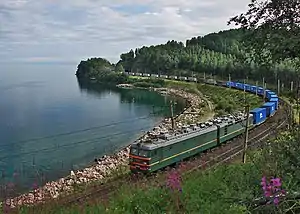 VL85 container haul along the coast of Lake Baikal (2008) | |||||||||||||||||||||||||||||||||||||||||||||||||||||||||||||||||||||||||||||||||||||||||||||||||||||||||||||||||||||||||||||||||||||||||||||||||||||||||||||||||||||||||||||||||||||||||||||||||||||||||||||||||||||||||||||||||||||||||||||||||||||||||||||||||||||||||||||||||||||||||||||||||||||||||||||||||||||||||||||||||||||||||||||||||||||||||||||||||||||||||||||||||||||||||||||||||||||||||||||||||||||||||||||||||||||||||||||||||||||||||||||||||||||||||||||||||||||||||||||||||||||||||||||||||||||||||||||||||||||||||||||||||||||||||||||||||||||||||||||||||||||||||||||||||||||||||||||||||||||||||||||||||||||||||||||||||||||||||||||||||||||||||||||||||||||||||||||||||||||||||||||||||||||||||||||||||||||||||||||||||||||||||||||||||||||||||||||||||||||||||||||||||||||||||||||||||||||||||||||||||||||||||||||||||||||||||||||||||||||||||||||||||||||||||||||||||||||||||||||||||||||||||||||||||||||||||||||||||||||||||||||||||||||||||||||||||||||||||||||||||||||||||||||||||||||||||||||||||||||||
| Overview | |||||||||||||||||||||||||||||||||||||||||||||||||||||||||||||||||||||||||||||||||||||||||||||||||||||||||||||||||||||||||||||||||||||||||||||||||||||||||||||||||||||||||||||||||||||||||||||||||||||||||||||||||||||||||||||||||||||||||||||||||||||||||||||||||||||||||||||||||||||||||||||||||||||||||||||||||||||||||||||||||||||||||||||||||||||||||||||||||||||||||||||||||||||||||||||||||||||||||||||||||||||||||||||||||||||||||||||||||||||||||||||||||||||||||||||||||||||||||||||||||||||||||||||||||||||||||||||||||||||||||||||||||||||||||||||||||||||||||||||||||||||||||||||||||||||||||||||||||||||||||||||||||||||||||||||||||||||||||||||||||||||||||||||||||||||||||||||||||||||||||||||||||||||||||||||||||||||||||||||||||||||||||||||||||||||||||||||||||||||||||||||||||||||||||||||||||||||||||||||||||||||||||||||||||||||||||||||||||||||||||||||||||||||||||||||||||||||||||||||||||||||||||||||||||||||||||||||||||||||||||||||||||||||||||||||||||||||||||||||||||||||||||||||||||||||||||||||||||||||||
| Native name | Транссибирская магистраль | ||||||||||||||||||||||||||||||||||||||||||||||||||||||||||||||||||||||||||||||||||||||||||||||||||||||||||||||||||||||||||||||||||||||||||||||||||||||||||||||||||||||||||||||||||||||||||||||||||||||||||||||||||||||||||||||||||||||||||||||||||||||||||||||||||||||||||||||||||||||||||||||||||||||||||||||||||||||||||||||||||||||||||||||||||||||||||||||||||||||||||||||||||||||||||||||||||||||||||||||||||||||||||||||||||||||||||||||||||||||||||||||||||||||||||||||||||||||||||||||||||||||||||||||||||||||||||||||||||||||||||||||||||||||||||||||||||||||||||||||||||||||||||||||||||||||||||||||||||||||||||||||||||||||||||||||||||||||||||||||||||||||||||||||||||||||||||||||||||||||||||||||||||||||||||||||||||||||||||||||||||||||||||||||||||||||||||||||||||||||||||||||||||||||||||||||||||||||||||||||||||||||||||||||||||||||||||||||||||||||||||||||||||||||||||||||||||||||||||||||||||||||||||||||||||||||||||||||||||||||||||||||||||||||||||||||||||||||||||||||||||||||||||||||||||||||||||||||||||||||
| Status | Operational | ||||||||||||||||||||||||||||||||||||||||||||||||||||||||||||||||||||||||||||||||||||||||||||||||||||||||||||||||||||||||||||||||||||||||||||||||||||||||||||||||||||||||||||||||||||||||||||||||||||||||||||||||||||||||||||||||||||||||||||||||||||||||||||||||||||||||||||||||||||||||||||||||||||||||||||||||||||||||||||||||||||||||||||||||||||||||||||||||||||||||||||||||||||||||||||||||||||||||||||||||||||||||||||||||||||||||||||||||||||||||||||||||||||||||||||||||||||||||||||||||||||||||||||||||||||||||||||||||||||||||||||||||||||||||||||||||||||||||||||||||||||||||||||||||||||||||||||||||||||||||||||||||||||||||||||||||||||||||||||||||||||||||||||||||||||||||||||||||||||||||||||||||||||||||||||||||||||||||||||||||||||||||||||||||||||||||||||||||||||||||||||||||||||||||||||||||||||||||||||||||||||||||||||||||||||||||||||||||||||||||||||||||||||||||||||||||||||||||||||||||||||||||||||||||||||||||||||||||||||||||||||||||||||||||||||||||||||||||||||||||||||||||||||||||||||||||||||||||||||||
| Owner | Government of Russia | ||||||||||||||||||||||||||||||||||||||||||||||||||||||||||||||||||||||||||||||||||||||||||||||||||||||||||||||||||||||||||||||||||||||||||||||||||||||||||||||||||||||||||||||||||||||||||||||||||||||||||||||||||||||||||||||||||||||||||||||||||||||||||||||||||||||||||||||||||||||||||||||||||||||||||||||||||||||||||||||||||||||||||||||||||||||||||||||||||||||||||||||||||||||||||||||||||||||||||||||||||||||||||||||||||||||||||||||||||||||||||||||||||||||||||||||||||||||||||||||||||||||||||||||||||||||||||||||||||||||||||||||||||||||||||||||||||||||||||||||||||||||||||||||||||||||||||||||||||||||||||||||||||||||||||||||||||||||||||||||||||||||||||||||||||||||||||||||||||||||||||||||||||||||||||||||||||||||||||||||||||||||||||||||||||||||||||||||||||||||||||||||||||||||||||||||||||||||||||||||||||||||||||||||||||||||||||||||||||||||||||||||||||||||||||||||||||||||||||||||||||||||||||||||||||||||||||||||||||||||||||||||||||||||||||||||||||||||||||||||||||||||||||||||||||||||||||||||||||||||
| Locale | |||||||||||||||||||||||||||||||||||||||||||||||||||||||||||||||||||||||||||||||||||||||||||||||||||||||||||||||||||||||||||||||||||||||||||||||||||||||||||||||||||||||||||||||||||||||||||||||||||||||||||||||||||||||||||||||||||||||||||||||||||||||||||||||||||||||||||||||||||||||||||||||||||||||||||||||||||||||||||||||||||||||||||||||||||||||||||||||||||||||||||||||||||||||||||||||||||||||||||||||||||||||||||||||||||||||||||||||||||||||||||||||||||||||||||||||||||||||||||||||||||||||||||||||||||||||||||||||||||||||||||||||||||||||||||||||||||||||||||||||||||||||||||||||||||||||||||||||||||||||||||||||||||||||||||||||||||||||||||||||||||||||||||||||||||||||||||||||||||||||||||||||||||||||||||||||||||||||||||||||||||||||||||||||||||||||||||||||||||||||||||||||||||||||||||||||||||||||||||||||||||||||||||||||||||||||||||||||||||||||||||||||||||||||||||||||||||||||||||||||||||||||||||||||||||||||||||||||||||||||||||||||||||||||||||||||||||||||||||||||||||||||||||||||||||||||||||||||||||||||
| Termini |
| ||||||||||||||||||||||||||||||||||||||||||||||||||||||||||||||||||||||||||||||||||||||||||||||||||||||||||||||||||||||||||||||||||||||||||||||||||||||||||||||||||||||||||||||||||||||||||||||||||||||||||||||||||||||||||||||||||||||||||||||||||||||||||||||||||||||||||||||||||||||||||||||||||||||||||||||||||||||||||||||||||||||||||||||||||||||||||||||||||||||||||||||||||||||||||||||||||||||||||||||||||||||||||||||||||||||||||||||||||||||||||||||||||||||||||||||||||||||||||||||||||||||||||||||||||||||||||||||||||||||||||||||||||||||||||||||||||||||||||||||||||||||||||||||||||||||||||||||||||||||||||||||||||||||||||||||||||||||||||||||||||||||||||||||||||||||||||||||||||||||||||||||||||||||||||||||||||||||||||||||||||||||||||||||||||||||||||||||||||||||||||||||||||||||||||||||||||||||||||||||||||||||||||||||||||||||||||||||||||||||||||||||||||||||||||||||||||||||||||||||||||||||||||||||||||||||||||||||||||||||||||||||||||||||||||||||||||||||||||||||||||||||||||||||||||||||||||||||||||||||
| Service | |||||||||||||||||||||||||||||||||||||||||||||||||||||||||||||||||||||||||||||||||||||||||||||||||||||||||||||||||||||||||||||||||||||||||||||||||||||||||||||||||||||||||||||||||||||||||||||||||||||||||||||||||||||||||||||||||||||||||||||||||||||||||||||||||||||||||||||||||||||||||||||||||||||||||||||||||||||||||||||||||||||||||||||||||||||||||||||||||||||||||||||||||||||||||||||||||||||||||||||||||||||||||||||||||||||||||||||||||||||||||||||||||||||||||||||||||||||||||||||||||||||||||||||||||||||||||||||||||||||||||||||||||||||||||||||||||||||||||||||||||||||||||||||||||||||||||||||||||||||||||||||||||||||||||||||||||||||||||||||||||||||||||||||||||||||||||||||||||||||||||||||||||||||||||||||||||||||||||||||||||||||||||||||||||||||||||||||||||||||||||||||||||||||||||||||||||||||||||||||||||||||||||||||||||||||||||||||||||||||||||||||||||||||||||||||||||||||||||||||||||||||||||||||||||||||||||||||||||||||||||||||||||||||||||||||||||||||||||||||||||||||||||||||||||||||||||||||||||||||||
| Type |
| ||||||||||||||||||||||||||||||||||||||||||||||||||||||||||||||||||||||||||||||||||||||||||||||||||||||||||||||||||||||||||||||||||||||||||||||||||||||||||||||||||||||||||||||||||||||||||||||||||||||||||||||||||||||||||||||||||||||||||||||||||||||||||||||||||||||||||||||||||||||||||||||||||||||||||||||||||||||||||||||||||||||||||||||||||||||||||||||||||||||||||||||||||||||||||||||||||||||||||||||||||||||||||||||||||||||||||||||||||||||||||||||||||||||||||||||||||||||||||||||||||||||||||||||||||||||||||||||||||||||||||||||||||||||||||||||||||||||||||||||||||||||||||||||||||||||||||||||||||||||||||||||||||||||||||||||||||||||||||||||||||||||||||||||||||||||||||||||||||||||||||||||||||||||||||||||||||||||||||||||||||||||||||||||||||||||||||||||||||||||||||||||||||||||||||||||||||||||||||||||||||||||||||||||||||||||||||||||||||||||||||||||||||||||||||||||||||||||||||||||||||||||||||||||||||||||||||||||||||||||||||||||||||||||||||||||||||||||||||||||||||||||||||||||||||||||||||||||||||||||
| System | FER, SZhD, V-SibZhD, Z-SibZhD, KrasZhD, SvZhD, ZabZhD | ||||||||||||||||||||||||||||||||||||||||||||||||||||||||||||||||||||||||||||||||||||||||||||||||||||||||||||||||||||||||||||||||||||||||||||||||||||||||||||||||||||||||||||||||||||||||||||||||||||||||||||||||||||||||||||||||||||||||||||||||||||||||||||||||||||||||||||||||||||||||||||||||||||||||||||||||||||||||||||||||||||||||||||||||||||||||||||||||||||||||||||||||||||||||||||||||||||||||||||||||||||||||||||||||||||||||||||||||||||||||||||||||||||||||||||||||||||||||||||||||||||||||||||||||||||||||||||||||||||||||||||||||||||||||||||||||||||||||||||||||||||||||||||||||||||||||||||||||||||||||||||||||||||||||||||||||||||||||||||||||||||||||||||||||||||||||||||||||||||||||||||||||||||||||||||||||||||||||||||||||||||||||||||||||||||||||||||||||||||||||||||||||||||||||||||||||||||||||||||||||||||||||||||||||||||||||||||||||||||||||||||||||||||||||||||||||||||||||||||||||||||||||||||||||||||||||||||||||||||||||||||||||||||||||||||||||||||||||||||||||||||||||||||||||||||||||||||||||||||||
| Operator(s) | Russian Railways | ||||||||||||||||||||||||||||||||||||||||||||||||||||||||||||||||||||||||||||||||||||||||||||||||||||||||||||||||||||||||||||||||||||||||||||||||||||||||||||||||||||||||||||||||||||||||||||||||||||||||||||||||||||||||||||||||||||||||||||||||||||||||||||||||||||||||||||||||||||||||||||||||||||||||||||||||||||||||||||||||||||||||||||||||||||||||||||||||||||||||||||||||||||||||||||||||||||||||||||||||||||||||||||||||||||||||||||||||||||||||||||||||||||||||||||||||||||||||||||||||||||||||||||||||||||||||||||||||||||||||||||||||||||||||||||||||||||||||||||||||||||||||||||||||||||||||||||||||||||||||||||||||||||||||||||||||||||||||||||||||||||||||||||||||||||||||||||||||||||||||||||||||||||||||||||||||||||||||||||||||||||||||||||||||||||||||||||||||||||||||||||||||||||||||||||||||||||||||||||||||||||||||||||||||||||||||||||||||||||||||||||||||||||||||||||||||||||||||||||||||||||||||||||||||||||||||||||||||||||||||||||||||||||||||||||||||||||||||||||||||||||||||||||||||||||||||||||||||||||||
| History | |||||||||||||||||||||||||||||||||||||||||||||||||||||||||||||||||||||||||||||||||||||||||||||||||||||||||||||||||||||||||||||||||||||||||||||||||||||||||||||||||||||||||||||||||||||||||||||||||||||||||||||||||||||||||||||||||||||||||||||||||||||||||||||||||||||||||||||||||||||||||||||||||||||||||||||||||||||||||||||||||||||||||||||||||||||||||||||||||||||||||||||||||||||||||||||||||||||||||||||||||||||||||||||||||||||||||||||||||||||||||||||||||||||||||||||||||||||||||||||||||||||||||||||||||||||||||||||||||||||||||||||||||||||||||||||||||||||||||||||||||||||||||||||||||||||||||||||||||||||||||||||||||||||||||||||||||||||||||||||||||||||||||||||||||||||||||||||||||||||||||||||||||||||||||||||||||||||||||||||||||||||||||||||||||||||||||||||||||||||||||||||||||||||||||||||||||||||||||||||||||||||||||||||||||||||||||||||||||||||||||||||||||||||||||||||||||||||||||||||||||||||||||||||||||||||||||||||||||||||||||||||||||||||||||||||||||||||||||||||||||||||||||||||||||||||||||||||||||||||||
| Commenced | 9 March 1891 | ||||||||||||||||||||||||||||||||||||||||||||||||||||||||||||||||||||||||||||||||||||||||||||||||||||||||||||||||||||||||||||||||||||||||||||||||||||||||||||||||||||||||||||||||||||||||||||||||||||||||||||||||||||||||||||||||||||||||||||||||||||||||||||||||||||||||||||||||||||||||||||||||||||||||||||||||||||||||||||||||||||||||||||||||||||||||||||||||||||||||||||||||||||||||||||||||||||||||||||||||||||||||||||||||||||||||||||||||||||||||||||||||||||||||||||||||||||||||||||||||||||||||||||||||||||||||||||||||||||||||||||||||||||||||||||||||||||||||||||||||||||||||||||||||||||||||||||||||||||||||||||||||||||||||||||||||||||||||||||||||||||||||||||||||||||||||||||||||||||||||||||||||||||||||||||||||||||||||||||||||||||||||||||||||||||||||||||||||||||||||||||||||||||||||||||||||||||||||||||||||||||||||||||||||||||||||||||||||||||||||||||||||||||||||||||||||||||||||||||||||||||||||||||||||||||||||||||||||||||||||||||||||||||||||||||||||||||||||||||||||||||||||||||||||||||||||||||||||||||||
| Opened | 21 June 1904 | ||||||||||||||||||||||||||||||||||||||||||||||||||||||||||||||||||||||||||||||||||||||||||||||||||||||||||||||||||||||||||||||||||||||||||||||||||||||||||||||||||||||||||||||||||||||||||||||||||||||||||||||||||||||||||||||||||||||||||||||||||||||||||||||||||||||||||||||||||||||||||||||||||||||||||||||||||||||||||||||||||||||||||||||||||||||||||||||||||||||||||||||||||||||||||||||||||||||||||||||||||||||||||||||||||||||||||||||||||||||||||||||||||||||||||||||||||||||||||||||||||||||||||||||||||||||||||||||||||||||||||||||||||||||||||||||||||||||||||||||||||||||||||||||||||||||||||||||||||||||||||||||||||||||||||||||||||||||||||||||||||||||||||||||||||||||||||||||||||||||||||||||||||||||||||||||||||||||||||||||||||||||||||||||||||||||||||||||||||||||||||||||||||||||||||||||||||||||||||||||||||||||||||||||||||||||||||||||||||||||||||||||||||||||||||||||||||||||||||||||||||||||||||||||||||||||||||||||||||||||||||||||||||||||||||||||||||||||||||||||||||||||||||||||||||||||||||||||||||||||
| Technical | |||||||||||||||||||||||||||||||||||||||||||||||||||||||||||||||||||||||||||||||||||||||||||||||||||||||||||||||||||||||||||||||||||||||||||||||||||||||||||||||||||||||||||||||||||||||||||||||||||||||||||||||||||||||||||||||||||||||||||||||||||||||||||||||||||||||||||||||||||||||||||||||||||||||||||||||||||||||||||||||||||||||||||||||||||||||||||||||||||||||||||||||||||||||||||||||||||||||||||||||||||||||||||||||||||||||||||||||||||||||||||||||||||||||||||||||||||||||||||||||||||||||||||||||||||||||||||||||||||||||||||||||||||||||||||||||||||||||||||||||||||||||||||||||||||||||||||||||||||||||||||||||||||||||||||||||||||||||||||||||||||||||||||||||||||||||||||||||||||||||||||||||||||||||||||||||||||||||||||||||||||||||||||||||||||||||||||||||||||||||||||||||||||||||||||||||||||||||||||||||||||||||||||||||||||||||||||||||||||||||||||||||||||||||||||||||||||||||||||||||||||||||||||||||||||||||||||||||||||||||||||||||||||||||||||||||||||||||||||||||||||||||||||||||||||||||||||||||||||||||
| Line length | 9,289 km (5,772 mi) | ||||||||||||||||||||||||||||||||||||||||||||||||||||||||||||||||||||||||||||||||||||||||||||||||||||||||||||||||||||||||||||||||||||||||||||||||||||||||||||||||||||||||||||||||||||||||||||||||||||||||||||||||||||||||||||||||||||||||||||||||||||||||||||||||||||||||||||||||||||||||||||||||||||||||||||||||||||||||||||||||||||||||||||||||||||||||||||||||||||||||||||||||||||||||||||||||||||||||||||||||||||||||||||||||||||||||||||||||||||||||||||||||||||||||||||||||||||||||||||||||||||||||||||||||||||||||||||||||||||||||||||||||||||||||||||||||||||||||||||||||||||||||||||||||||||||||||||||||||||||||||||||||||||||||||||||||||||||||||||||||||||||||||||||||||||||||||||||||||||||||||||||||||||||||||||||||||||||||||||||||||||||||||||||||||||||||||||||||||||||||||||||||||||||||||||||||||||||||||||||||||||||||||||||||||||||||||||||||||||||||||||||||||||||||||||||||||||||||||||||||||||||||||||||||||||||||||||||||||||||||||||||||||||||||||||||||||||||||||||||||||||||||||||||||||||||||||||||||||||||
| Number of tracks | 2 | ||||||||||||||||||||||||||||||||||||||||||||||||||||||||||||||||||||||||||||||||||||||||||||||||||||||||||||||||||||||||||||||||||||||||||||||||||||||||||||||||||||||||||||||||||||||||||||||||||||||||||||||||||||||||||||||||||||||||||||||||||||||||||||||||||||||||||||||||||||||||||||||||||||||||||||||||||||||||||||||||||||||||||||||||||||||||||||||||||||||||||||||||||||||||||||||||||||||||||||||||||||||||||||||||||||||||||||||||||||||||||||||||||||||||||||||||||||||||||||||||||||||||||||||||||||||||||||||||||||||||||||||||||||||||||||||||||||||||||||||||||||||||||||||||||||||||||||||||||||||||||||||||||||||||||||||||||||||||||||||||||||||||||||||||||||||||||||||||||||||||||||||||||||||||||||||||||||||||||||||||||||||||||||||||||||||||||||||||||||||||||||||||||||||||||||||||||||||||||||||||||||||||||||||||||||||||||||||||||||||||||||||||||||||||||||||||||||||||||||||||||||||||||||||||||||||||||||||||||||||||||||||||||||||||||||||||||||||||||||||||||||||||||||||||||||||||||||||||||||||
| Character | Long-haul route | ||||||||||||||||||||||||||||||||||||||||||||||||||||||||||||||||||||||||||||||||||||||||||||||||||||||||||||||||||||||||||||||||||||||||||||||||||||||||||||||||||||||||||||||||||||||||||||||||||||||||||||||||||||||||||||||||||||||||||||||||||||||||||||||||||||||||||||||||||||||||||||||||||||||||||||||||||||||||||||||||||||||||||||||||||||||||||||||||||||||||||||||||||||||||||||||||||||||||||||||||||||||||||||||||||||||||||||||||||||||||||||||||||||||||||||||||||||||||||||||||||||||||||||||||||||||||||||||||||||||||||||||||||||||||||||||||||||||||||||||||||||||||||||||||||||||||||||||||||||||||||||||||||||||||||||||||||||||||||||||||||||||||||||||||||||||||||||||||||||||||||||||||||||||||||||||||||||||||||||||||||||||||||||||||||||||||||||||||||||||||||||||||||||||||||||||||||||||||||||||||||||||||||||||||||||||||||||||||||||||||||||||||||||||||||||||||||||||||||||||||||||||||||||||||||||||||||||||||||||||||||||||||||||||||||||||||||||||||||||||||||||||||||||||||||||||||||||||||||||||
| Track gauge | 1,520 mm (4 ft 11+27⁄32 in) Russian gauge | ||||||||||||||||||||||||||||||||||||||||||||||||||||||||||||||||||||||||||||||||||||||||||||||||||||||||||||||||||||||||||||||||||||||||||||||||||||||||||||||||||||||||||||||||||||||||||||||||||||||||||||||||||||||||||||||||||||||||||||||||||||||||||||||||||||||||||||||||||||||||||||||||||||||||||||||||||||||||||||||||||||||||||||||||||||||||||||||||||||||||||||||||||||||||||||||||||||||||||||||||||||||||||||||||||||||||||||||||||||||||||||||||||||||||||||||||||||||||||||||||||||||||||||||||||||||||||||||||||||||||||||||||||||||||||||||||||||||||||||||||||||||||||||||||||||||||||||||||||||||||||||||||||||||||||||||||||||||||||||||||||||||||||||||||||||||||||||||||||||||||||||||||||||||||||||||||||||||||||||||||||||||||||||||||||||||||||||||||||||||||||||||||||||||||||||||||||||||||||||||||||||||||||||||||||||||||||||||||||||||||||||||||||||||||||||||||||||||||||||||||||||||||||||||||||||||||||||||||||||||||||||||||||||||||||||||||||||||||||||||||||||||||||||||||||||||||||||||||||||||
| Electrification | 25 kV 50 Hz AC overhead line | ||||||||||||||||||||||||||||||||||||||||||||||||||||||||||||||||||||||||||||||||||||||||||||||||||||||||||||||||||||||||||||||||||||||||||||||||||||||||||||||||||||||||||||||||||||||||||||||||||||||||||||||||||||||||||||||||||||||||||||||||||||||||||||||||||||||||||||||||||||||||||||||||||||||||||||||||||||||||||||||||||||||||||||||||||||||||||||||||||||||||||||||||||||||||||||||||||||||||||||||||||||||||||||||||||||||||||||||||||||||||||||||||||||||||||||||||||||||||||||||||||||||||||||||||||||||||||||||||||||||||||||||||||||||||||||||||||||||||||||||||||||||||||||||||||||||||||||||||||||||||||||||||||||||||||||||||||||||||||||||||||||||||||||||||||||||||||||||||||||||||||||||||||||||||||||||||||||||||||||||||||||||||||||||||||||||||||||||||||||||||||||||||||||||||||||||||||||||||||||||||||||||||||||||||||||||||||||||||||||||||||||||||||||||||||||||||||||||||||||||||||||||||||||||||||||||||||||||||||||||||||||||||||||||||||||||||||||||||||||||||||||||||||||||||||||||||||||||||||||||
| |||||||||||||||||||||||||||||||||||||||||||||||||||||||||||||||||||||||||||||||||||||||||||||||||||||||||||||||||||||||||||||||||||||||||||||||||||||||||||||||||||||||||||||||||||||||||||||||||||||||||||||||||||||||||||||||||||||||||||||||||||||||||||||||||||||||||||||||||||||||||||||||||||||||||||||||||||||||||||||||||||||||||||||||||||||||||||||||||||||||||||||||||||||||||||||||||||||||||||||||||||||||||||||||||||||||||||||||||||||||||||||||||||||||||||||||||||||||||||||||||||||||||||||||||||||||||||||||||||||||||||||||||||||||||||||||||||||||||||||||||||||||||||||||||||||||||||||||||||||||||||||||||||||||||||||||||||||||||||||||||||||||||||||||||||||||||||||||||||||||||||||||||||||||||||||||||||||||||||||||||||||||||||||||||||||||||||||||||||||||||||||||||||||||||||||||||||||||||||||||||||||||||||||||||||||||||||||||||||||||||||||||||||||||||||||||||||||||||||||||||||||||||||||||||||||||||||||||||||||||||||||||||||||||||||||||||||||||||||||||||||||||||||||||||||||||||||||||||||||||
During the period of the Russian Empire, government ministers—personally appointed by Alexander III and his son Nicholas II—supervised the building of the railway network between 1891 and 1916. Even before its completion, the line attracted travellers who documented their experiences.[3] Since 1916, the Trans-Siberian Railway has directly connected Moscow with Vladivostok. As of 2021, expansion projects remain underway, with connections being built to Russia's neighbouring countries (namely Mongolia, China, and North Korea).[4][5] Additionally, there have been proposals and talks to expand the network to Tokyo, Japan, with new bridges that would connect the mainland railway through the Russian island of Sakhalin and the Japanese island of Hokkaido.[4]
Route description
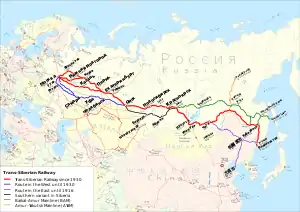
The railway is often associated with the main transcontinental Russian line that connects hundreds of large and small cities of the European and Asian parts of Russia. At a Moscow–Vladivostok track length of 9,289 kilometres (5,772 miles),[6] it spans a record eight time zones.[7] Taking eight days to complete the journey, it is the third-longest single continuous service in the world, after the Moscow–Pyongyang 10,267 kilometres (6,380 mi)[8] and the Kyiv–Vladivostok 11,085 kilometres (6,888 mi)[9] services, both of which also follow the Trans-Siberian for much of their routes.[10]
The main route of the Trans-Siberian Railway begins in Moscow at Yaroslavsky Vokzal, runs through Yaroslavl or Chelyabinsk, Omsk, Novosibirsk, Krasnoyarsk, Irkutsk, Ulan-Ude, Chita, and Khabarovsk to Vladivostok via southern Siberia. A second primary route is the Trans-Manchurian, which coincides with the Trans-Siberian east of Chita as far as Tarskaya (a stop 12 km (7 mi) east of Karymskoye, in Chita Oblast), about 1,000 km (621 mi) east of Lake Baikal. From Tarskaya the Trans-Manchurian heads southeast, via Harbin and Mudanjiang in China's Northeastern Provinces (from where a connection to Beijing is used by one of the Moscow–Beijing trains), joining with the main route in Ussuriysk just north of Vladivostok. This is the shortest and the oldest railway route to Vladivostok. While there are currently no traverse passenger services (enter China from one side and then exit China and return to Russia on the other side) on this branch, it is still used by several international passenger services between Russia and China.
The third primary route is the Trans-Mongolian Railway, which coincides with the Trans-Siberian as far as Ulan-Ude on Lake Baikal's eastern shore. From Ulan-Ude the Trans-Mongolian heads south to Ulaan-Baatar before making its way southeast to Beijing. In 1991, a fourth route running further to the north was finally completed, after more than five decades of sporadic work. Known as the Baikal Amur Mainline (BAM), this recent extension departs from the Trans-Siberian line at Taishet several hundred miles west of Lake Baikal and passes the lake at its northernmost extremity. It crosses the Amur River at Komsomolsk-na-Amure (north of Khabarovsk), and reaches the Tatar Strait at Sovetskaya Gavan. [11]
History
Demand and design
In the late 19th century, the development of Siberia was hampered by poor transport links within the region, as well as with the rest of the country. Aside from the Great Siberian Route, good roads suitable for wheeled transport were rare. For about five months of the year, rivers were the main means of transport. During the cold half of the year, cargo and passengers travelled by horse-drawn sledges over the winter roads, many of which were the same rivers, but ice-covered.[12]
The first steamboat on the River Ob, Nikita Myasnikov's Osnova, was launched in 1844. But early beginnings were difficult, and it was not until 1857 that steamboat shipping started developing on the Ob system in a serious way. Steamboats started operating on the Yenisei in 1863, and on the Lena and Amur in the 1870s. While the comparative flatness of Western Siberia was at least fairly well served by the gigantic Ob–Irtysh–Tobol–Chulym river system, the mighty rivers of Eastern Siberia—the Yenisei, the upper course of the Angara River (the Angara below Bratsk was not easily navigable because of the rapids), and the Lena—were mostly navigable only in the north-south direction. An attempt to partially remedy the situation by building the Ob-Yenisei Canal was not particularly successful. Only a railway could be a real solution to the region's transport problems. [13]
The first railway projects in Siberia emerged after the completion of the Saint Petersburg–Moscow Railway in 1851.[14] One of the first was the Irkutsk–Chita project, proposed by the American entrepreneur Perry Collins and supported by Transport Minister Constantine Possiet with a view toward connecting Moscow to the Amur River, and consequently, to the Pacific Ocean. Siberia's governor, Nikolay Muravyov-Amursky, was anxious to advance the colonisation of the Russian Far East, but his plans could not materialise as long as the colonists had to import grain and other food from China and Korea.[15] It was on Muravyov's initiative that surveys for a railway in the Khabarovsk region were conducted.
Before 1880, the central government had virtually ignored these projects, because of the weakness of Siberian enterprises, a clumsy bureaucracy, and fear of financial risk. By 1880, there were a large number of rejected and upcoming applications for permission to construct railways to connect Siberia with the Pacific, but not Eastern Russia. This worried the government and made connecting Siberia with Central Russia a pressing concern. The design process lasted 10 years. Along with the route actually constructed, alternative projects were proposed:
- Southern route: via Kazakhstan, Barnaul, Abakan and Mongolia.
- Northern route: via Tyumen, Tobolsk, Tomsk, Yeniseysk and the modern Baikal Amur Mainline or even through Yakutsk.
The line was divided into seven sections, on all or most of which work proceeded simultaneously using the labour of 62,000 men. With financial support provided by leading European financier, Baron Henri Hottinguer of the Parisian bankers Hottinger & Cie, the total cost estimated at £35 million was raised with the first section (Chelyabinsk to the River Ob) was finished at a cost £900,000 less than the estimate.[16] Railwaymen fought against suggestions to save funds, for example, by installing ferryboats instead of bridges over the rivers until traffic increased. The designers insisted and secured the decision to construct an uninterrupted railway.
Unlike the rejected private projects that intended to connect the existing cities demanding transport, the Trans-Siberian did not have such a priority. Thus, to save money and avoid clashes with land owners, it was decided to lay the railway outside the existing cities. Tomsk was the largest city, and the most unfortunate, because the swampy banks of the Ob River near it were considered inappropriate for a bridge. The railway was laid 70 km (43 mi) to the south (instead crossing the Ob at Novonikolaevsk, later renamed Novosibirsk); just a dead-end branch line connected with Tomsk, depriving the city of the prospective transit railway traffic and trade. [17]
Construction
.jpg.webp)

On 9 March 1891, the Russian government issued an imperial rescript in which it announced its intention to construct a railway across Siberia.[18] Tsarevich Nicholas (later Tsar Nicholas II) inaugurated the construction of the railway in Vladivostok on 19 May that year.[19]
Lake Baikal is more than 640 kilometres (400 miles) long and more than 1,600 metres (5,200 feet) deep. Until the Circum-Baikal Railway was built the line ended on either side of the lake. The ice-breaking train ferry SS Baikal built in 1897 and smaller ferry SS Angara built in about 1900 made the four-hour crossing to link the two railheads.[20][21]
The Russian admiral and explorer Stepan Makarov (1849–1904) designed Baikal and Angara but they were built in Newcastle upon Tyne, by Armstrong Whitworth. They were "knock down" vessels; that is, each ship was bolted together in the United Kingdom, every part of the ship was marked with a number, the ship was disassembled into many hundreds of parts and transported in kit form to Listvyanka where a shipyard was built especially to reassemble them.[21] Their boilers, engines and some other components were built in Saint Petersburg[21] and transported to Listvyanka to be installed. Baikal had 15 boilers, four funnels, and was 64 metres (210 ft) long. it could carry 24 railway coaches and one locomotive on the middle deck. Angara was smaller, with two funnels.[20][21]
Completion of the Circum-Baikal Railway in 1904 bypassed the ferries, but from time to time the Circum-Baikal Railway suffered from derailments or rockfalls so both ships were held in reserve until 1916. Baikal was burnt out and destroyed in the Russian Civil War[20][21] but Angara survives. It has been restored and is permanently moored at Irkutsk where it serves as an office and a museum.[20]
In winter, sleighs were used to move passengers and cargo from one side of the lake to the other until the completion of the Lake Baikal spur along the southern edge of the lake. With the Amur River Line north of the Chinese border being completed in 1916, there was a continuous railway from Petrograd to Vladivostok that, to this day, is the world's second longest railway line. Electrification of the line, begun in 1929 and completed in 2002, allowed a doubling of train weights to 6,000 tonnes. There were expectations upon electrification that it would increase rail traffic on the line by 40 percent.[22]
Effects
.jpg.webp)
Siberian agriculture began to send cheap grain westwards beginning around 1869. Agriculture in Central Russia was still under economic pressure after the end of serfdom, which was formally abolished in 1861. To defend the central territory and prevent possible social destabilisation, the Tsarist government introduced the Chelyabinsk tariff-break (Челябинский тарифный перелом) in 1896, a tariff barrier for grain passing through Chelyabinsk, and a similar barrier in Manchuria. This measure changed the nature of export: mills emerged to produce bread from grain in Altai Krai, Novosibirsk and Tomsk, and many farms switched to corn (maize) production.
The railway immediately filled to capacity with local traffic, mostly wheat. From 1896 until 1913 Siberia exported on average 501,932 tonnes (30,643,000 pood) of grain and flour annually.[23] During the Russo-Japanese War of 1904–1905, military traffic to the east disrupted the flow of civil freight.
The Trans-Siberian Railway brought with it millions of peasant-migrants from the Western regions of Russia and Ukraine.[24] Between 1906 and 1914, the peak migration years, about 4 million peasants arrived in Siberia.[25]
Historian Christian Wolmar argues that the railroad was a failure, because it was built for narrow political reasons, with poor supervision and planning. The costs were vastly exaggerated to enrich greedy bureaucrats. The planners hoped it would stimulate settlement, but the Siberian lands were too fertile and cold and distant. There was little settlement beyond 30 miles from the line. The fragile system could not handle the heavy traffic demanded in wartime, so the Japanese in 1904 knew they were safe in their war with Russia. Wolmar concludes:
The railway, which was single track throughout, with the occasional passing loop, had, unsurprisingly, been built to a deficient standard in virtually every way. The permanent way was flimsy, with lightweight rails that broke easily, insufficient ballast, and railroad ties often carved from green wood that rotted in the first year of use. The small bridges were made of soft pine and rotted easily. The embankments were too shallow and narrow, often just 10 ft wide instead of the 16 ft prescribed in the design, and easily washed away. There were vicious gradients and narrow curves that wore out the fringe flanges on the wheels of the rolling stock after his little as six weeks use.[26]
War and revolution
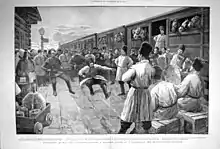
In the Russo-Japanese War (1904–1905), the strategic importance and limitations of the Trans-Siberian Railway contributed to Russia's defeat in the war. As the line was single track, transit was slower as trains had to wait in crossing sidings for opposing trains to cross. This limited the capacity of the line and increased transit times. A troop train or a train carrying injured personnel travelling from east to west would delay the arrival of troops or supplies and ammunition in a train travelling from west to east. The supply difficulties meant the Russian forces had limited troops and supplies while Japanese forces with shorter lines of communication were able to attack and advance.
After the Russian Revolution of 1917, the railway served as the vital line of communication for the Czechoslovak Legion and the allied armies that landed troops at Vladivostok during the Siberian Intervention of the Russian Civil War. These forces supported the White Russian government of Admiral Alexander Kolchak, based in Omsk, and White Russian soldiers fighting the Bolsheviks on the Ural front. The intervention was weakened, and ultimately defeated, by partisan fighters who blew up bridges and sections of track, particularly in the volatile region between Krasnoyarsk and Chita.[27]
There was traveling the leader of legions professor Thomas Garrigue Masaryk from Moscow to Vladivostok in March and August 1918, on his journey to Japan and United States of America.[28] The Trans-Siberian Railway also played a very direct role during parts of Russia's history, with the Czechoslovak Legion using heavily armed and armoured trains to control large amounts of the railway (and of Russia itself) during the Russian Civil War at the end of World War I.[29] As one of the few organised fighting forces left in the aftermath of the imperial collapse, and before the Red Army took control, the Czechs and Slovaks were able to use their organisation and the resources of the railway to establish a temporary zone of control before eventually continuing onwards towards Vladivostok, from where they emigrated back to Czechoslovakia.
World War II
During World War II, the Trans-Siberian Railway played an important role in the supply of the powers fighting in Europe. In 1939-1941 it was a source of rubber for Germany thanks to the USSR-Germany pact. While Germany's merchant shipping was shut down, the Trans-Siberian Railway (along with its Trans-Manchurian branch) served as the essential link between Germany and Japan, especially rubber. By March 1941, 300 tonnes of this material would, on average, traverse the Trans-Siberian Railway every day on its way to Germany.[30]
At the same time, a number of Jews and anti-Nazis used the Trans-Siberian Railway to escape Europe, including the mathematician Kurt Gödel and Betty Ehrlich Löwenstein, mother of British actor, director and producer Heinz Bernard.[31] Several thousand Jewish refugees were able to make this trip thanks to the Curaçao visas issued by the Dutch consul Jan Zwartendijk[32] and the Japanese visas issued by the Japanese consul, Chiune Sugihara, in Kaunas, Lithuania. Typically, they took the TSR to Vladivostok, then by ship to US. Until June 1941, pro-Nazi ethnic Germans from the Americas used the TSR to go to Germany.[33]
The situation reversed after 22 June 1941. By invading the Soviet Union, Germany cut off its only reliable trade route to Japan. Instead, it had to use fast merchant ships and later large oceanic submarines to evade the Allied blockade. On the other hand, the USSR received Lend-Lease supplies from the US. Even after Japan went to war with the US, despite German complaints, Japan usually allowed Soviet ships to sail between the US and Vladivostok unmolested.[34] As a result, the Pacific Route – via northern Pacific Ocean and the TSR – became the safest connection between the US and the USSR.
Accordingly, it accounted for as much freight as the North Atlantic–Arctic and Iranian routes combined, though cargoes were limited to raw materials and non-military goods. From 1941–42 the TSR also played an important role in relocating Soviet industries from European Russia to Siberia in the face of the German invasion.
The TSR transported Soviet troops west from the Far East to take part in the Soviet counter-offensive in December 1941, and later east from Germany to the Japanese front in preparation for the Soviet–Japanese War of August 1945. Although the Japanese estimated that an attack was not likely before Spring 1946, Stavka had planned for a mid-August 1945 offensive, and had concealed the buildup of a force of 90 divisions; many had crossed Siberia in their vehicles to avoid straining the rail link.[35]
Today
.jpg.webp)
The Trans-Siberian line remains the most important transport link within Russia; around 30% of Russian exports travel on the line. While it attracts many foreign tourists, it gets most of its use from domestic passengers.
Today the Trans-Siberian Railway carries about 200,000 containers per year to Europe. Russian Railways intends to at least double the volume of container traffic on the Trans-Siberian and is developing a fleet of specialised cars and increasing terminal capacity at the ports by a factor of 3 to 4. By 2010, the volume of traffic between Russia and China could reach 60 million tons (54 million tonnes), most of which will go by the Trans-Siberian.[36]
With perfect coordination of the participating countries' railway authorities, a trainload of containers can be taken from Beijing to Hamburg, via the Trans-Mongolian and Trans-Siberian lines in as little as 15 days, but typical cargo transit times are usually significantly longer[37] and typical cargo transit time from Japan to major destinations in European Russia was reported as around 25 days.[38]
According to a 2009 report, the best travel times for cargo block trains from Russia's Pacific ports to the western border (of Russia, or perhaps of Belarus) were around 12 days, with trains making around 900 km (559 mi) per day, at a maximum operating speed of 80 km/h (50 mph). In early 2009; however, Russian Railways announced an ambitious "Trans-Siberian in Seven Days" programme; according to this plan, $11 billion will be invested over the next five years to make it possible for goods traffic to cover the same 9,000 km (5,592 mi) distance in just seven days. The plan will involve increasing the cargo trains' speed to 90 km/h (56 mph) in 2010–2012, and, at least on some sections, to 100 km/h (62 mph) by 2015. At these speeds, goods trains will be able to cover 1,500 km (932 mi) per day.[39]
Developments in shipping
On 11 January 2008, China, Mongolia, Russia, Belarus, Poland, and Germany agreed to collaborate on a cargo train service between Beijing and Hamburg.[40]
The railway can typically deliver containers in 1⁄3 to 1⁄2 of the time of a sea voyage, and in late 2009 announced a 20% reduction in its container shipping rates. With its 2009 rate schedule, the Trans-Siberian Railway will transport a forty-foot container to Poland from Yokohama for $2,820, or from Busan for $2,154.[41]
One of the most complicating factors related to such ventures is the fact that the CIS states' broad railway gauge is incompatible with China and Western and Central Europe's standard gauge. Therefore, a train travelling from China to Western Europe encounters gauge breaks twice: at the Chinese–Mongolian or the Chinese–Russian frontier and at the Ukrainian or the Belorussian border with Central European countries.
Trans-Siberian route in seven days
In 2008, the Russian Railways JSC (state company) launched a program for the accelerated delivery of containers cargo by block trains from the Far-Eastern ports (Vladivostok, Nakhodka and others) to the western borders of Russia, called "Transsib in 7 days". Within the framework of the program it is planned to decrease the cargo delivery time from the Far East from 11 days in 2008 to seven days in 2015. The length of the routes is about 10,000 km (6,200 mi). The speed of delivery via the block trains should increase from 900 km (560 mi) per day in 2008 to 1,500 km (930 mi) per day in 2015. The first accelerated experimental block-train was launched in February 2009 from Vladivostok to Moscow. The length of the route was about 9,300 km (5,800 mi), the actual time of the experimental train's delivery was 7 days and 5 hours, and the average route speed was up to 1,289 km (801 mi) per day. The maximum route speed of the train was 1,422 km (884 mi) per day.
Gallery
 Start of Trans-Siberian railway in Moscow
Start of Trans-Siberian railway in Moscow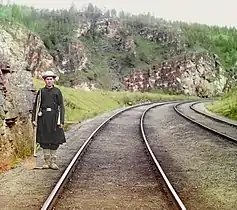 Bashkir switchman near the town Ust' Katav on the Yuryuzan River between Ufa and Chelyabinsk in the Ural Mountains region, c. 1910
Bashkir switchman near the town Ust' Katav on the Yuryuzan River between Ufa and Chelyabinsk in the Ural Mountains region, c. 1910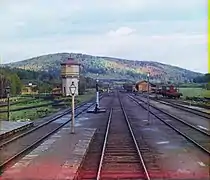 View from the rear platform of the Simskaia railway station of the Samara–Zlatoust Railway, c. 1910
View from the rear platform of the Simskaia railway station of the Samara–Zlatoust Railway, c. 1910 Almost every station on Trans-Siberian Railway has food sellers, often local vendors who sell local food such as fish (like Baikal omul), pirozhki, and potatoes. Besides food stands, there are also small kiosks
Almost every station on Trans-Siberian Railway has food sellers, often local vendors who sell local food such as fish (like Baikal omul), pirozhki, and potatoes. Besides food stands, there are also small kiosks Snow in late April at Nazyvayevsk station, Siberia
Snow in late April at Nazyvayevsk station, Siberia The train ferry SS Baikal in service on Lake Baikal
The train ferry SS Baikal in service on Lake Baikal Train entering a Circum-Baikal tunnel west of Kultuk
Train entering a Circum-Baikal tunnel west of Kultuk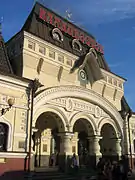 Vladivostok terminus of the Trans-Siberian Railway
Vladivostok terminus of the Trans-Siberian Railway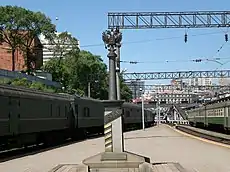 The marker for kilometre 9,288 (mile 5,771.3) at the end of the Trans-Siberian Railway at Vladivostok railway station
The marker for kilometre 9,288 (mile 5,771.3) at the end of the Trans-Siberian Railway at Vladivostok railway station Bridge over the Kama River, near Perm, built in 1912
Bridge over the Kama River, near Perm, built in 1912
Routes
Trans-Siberian line
A commonly used main line route is as follows. Distances and travel times are from the schedule of train No. 002M, Moscow–Vladivostok.[6]
| Location | Distance | Travel Time |
Time Zone | Notes |
|---|---|---|---|---|
| Moscow, Yaroslavsky Rail Terminal | 0 km (0 mi) | Moscow Time (MT) |
||
| Vladimir | 210 km (130 mi) | MT | ||
| Nizhny Novgorod | 461 km (286 mi) | 6 hours | MT | on the Volga River |
| Kirov | 917 km (570 mi) | 13 hours | MT | on the Vyatka River |
| Perm | 1,397 km (868 mi) | 20 hours | MT+2 | on the Kama River |
| Yekaterinburg | 1,816 km (1,128 mi) | 1 day 2 hours | MT+2 | in the Urals, still called by its old Soviet name Sverdlovsk in most timetables |
| Tyumen | 2,104 km (1,307 mi) | MT+2 | ||
| Omsk | 2,676 km (1,663 mi) | 1 day 14 hours | MT+3 | on the Irtysh River |
| Novosibirsk | 3,303 km (2,052 mi) | 1 day 22 hours | MT+4 | on the Ob River; Turk-Sib railway branches from here |
| Krasnoyarsk | 4,065 km (2,526 mi) | 2 days 11 hours | MT+4 | on the Yenisei River |
| Taishet | 4,483 km (2,786 mi) | MT+5 | junction with the Baikal-Amur Mainline | |
| Irkutsk | 5,153 km (3,202 mi) | 3 days 4 hours | MT+5 | near Lake Baikal's southern extremity |
| Ulan Ude | 5,609 km (3,485 mi) | 3 days 12 hours | MT+5 | eastern shore of Lake Baikal |
| Junction with the Trans-Mongolian line | 5,622 km (3,493 mi) | |||
| Chita | 6,166 km (3,831 mi) | 3 days 22 hours | MT+6 | |
| Junction with the Trans-Manchurian line at Tarskaya | 6,274 km (3,898 mi) | MT+6 | ||
| Birobidzhan | 8,312 km (5,165 mi) | 5 days 13 hours | MT+7 | capital of the Jewish Autonomous Region |
| Khabarovsk | 8,493 km (5,277 mi) | 5 days 15 hours | MT+7 | on the Amur River |
| Ussuriysk | 9,147 km (5,684 mi) | MT+7 | junction with the Trans-Manchurian line and Korea branch; located in Baranovsky, 13 km (8 miles) from Ussuriysk | |
| Vladivostok | 9,289 km (5,772 mi) | 6 days 4 hours | MT+7 | on the Pacific Ocean |
| Services to North Korea continue from Ussuriysk via: | ||||
| Primorskaya station | 9,257 km (5,752 mi) | 6 days 14 hours | MT+7 | |
| Khasan | 9,407 km (5,845 mi) | 6 days 19 hours | MT+7 | border with North Korea |
| Tumangang | 9,412 km (5,848 mi) | 7 days 10 hours | MT+6 | North Korean side of the border |
| Pyongyang | 10,267 km (6,380 mi) | 9 days 2 hours | MT+6 | |
There are many alternative routings between Moscow and Siberia. For example:
.jpg.webp)
- Some trains would leave Moscow from Kazansky Rail Terminal instead of Yaroslavsky Rail Terminal; this would save some 20 km (12 mi) off the distances, because it provides a shorter exit from Moscow onto the Nizhny Novgorod main line.
- One can take a night train from Moscow's Kursky Rail Terminal to Nizhny Novgorod, make a stopover in the Nizhny and then transfer to a Siberia-bound train
- From 1956 to 2001 many trains went between Moscow and Kirov via Yaroslavl instead of Nizhny Novgorod. This would add some 29 km (18 mi) to the distances from Moscow, making the total distance to Vladivostok at 9,288 km (5,771 mi).
- Other trains get from Moscow (Kazansky Terminal) to Yekaterinburg via Kazan.
- Between Yekaterinburg and Omsk it is possible to travel via Kurgan Petropavlovsk (in Kazakhstan) instead of Tyumen.
- One can bypass Yekaterinburg altogether by travelling via Samara, Ufa, Chelyabinsk and Petropavlovsk; this was historically the earliest configuration.
Depending on the route taken, the distances from Moscow to the same station in Siberia may differ by several tens of km (a few dozen miles).
Trans-Manchurian line
The Trans–Manchurian line, as e.g. used by train No.020, Moscow–Beijing[42] follows the same route as the Trans-Siberian between Moscow and Chita and then follows this route to China:
- Branch off from the Trans-Siberian-line at Tarskaya (6,274 km (3,898 mi) from Moscow)
- Zabaikalsk (6,626 km (4,117 mi)), Russian border town; there is a break-of-gauge
- Manzhouli (6,638 km (4,125 mi) from Moscow, 2,323 km (1,443 mi) from Beijing), Chinese border city
- Harbin (7,573 km (4,706 mi), 1,388 km) Chinese city
- Changchun (7,820 km (4,859 mi) from Moscow) Chinese city
- Beijing (8,961 km (5,568 mi) from Moscow) the Chinese capital
The express train (No. 020) travel time from Moscow to Beijing is just over six days. There is no direct passenger service along the entire original Trans-Manchurian route (i.e., from Moscow or anywhere in Russia, west of Manchuria, to Vladivostok via Harbin), due to the obvious administrative and technical (gauge break) inconveniences of crossing the border twice. Assuming sufficient patience and possession of appropriate visas, however, it is still possible to travel all the way along the original route, with a few stopovers (e.g. in Harbin, Grodekovo and Ussuriysk).
Such an itinerary would pass through the following points from Harbin east:
- Harbin (7,573 km (4,706 mi) from Moscow)
- Mudanjiang (7,928 km (4,926 mi))
- Suifenhe (8,121 km (5,046 mi)), the Chinese border station
- Grodekovo (8,147 km (5,062 mi)), Russia
- Ussuriysk (8,244 km (5,123 mi))
- Vladivostok (8,356 km (5,192 mi))
Trans-Mongolian line

The Trans–Mongolian line follows the same route as the Trans-Siberian between Moscow and Ulan Ude, and then follows this route to Mongolia and China:
- Branch off from the Trans-Siberian line (5,655 km (3,514 mi) from Moscow)
- Naushki (5,895 km (3,663 mi), MT+5), Russian border town
- Russian–Mongolian border (5,900 km (3,666 mi), MT+5)
- Sükhbaatar (5,921 km (3,679 mi), MT+5), Mongolian border town
- Ulaanbaatar (6,304 km (3,917 mi), MT+5), the Mongolian capital
- Zamyn-Üüd (7,013 km (4,358 mi), MT+5), Mongolian border city
- Erenhot (842 km (523 mi) from Beijing, MT+5), Chinese border city
- Datong (371 km (231 mi), MT+5) Chinese city
- Beijing (MT+5) the Chinese capital
Highest point
The highest point of Trans–Siberian Railroad is at Yablonovy pass at an altitude of 1070m situated in the Yablonoi Mountains, in Transbaikal (mainly in Zabaykalsky Krai), Siberia, Russia. The Trans–Siberian Railroad passes the mountains at Chita and runs parallel to the range before going through a tunnel to bypass the heights.[43]
See also
- Baikal–Amur Mainline
- Famous trains
- History of Siberia
- Russian gauge
- Russian Railways
- Sibirjak
- Starlight Express, a train musical in which a character is modeled on the Trans-Siberian Express.
- Trans-Siberian Railway Panorama
References
- "Lonely Planet Guide to the Trans-Siberian Railway" (PDF). Lonely Planet Publications. Archived from the original (PDF) on 5 September 2012.
- Thomas, Bryn; McCrohan, Daniel (2019). Trans-Siberian Handbook: The Guide to the World's Longest Railway Journey with 90 Maps and Guides to the Route, Cities and Towns in Russia, Mongolia and China (10 ed.). Trailblazer Publications. ISBN 978-1912716081. Retrieved 15 October 2020.
- Meakin, Annette, A Ribbon of Iron (1901), reprinted in 1970 as part of the Russia Observed series (Arno Press/New York Times)(OCLC 118166).
- "Russia offers a bridge across history to connect Tokyo to the Trans-Siberian railway". siberiantimes.com. Retrieved 2020-11-11.
- "New 8,400 mile train journey will connect London to Tokyo". The Independent. 2017-09-08. Retrieved 2020-11-11.
- "CIS railway timetable, route No. 002, Moscow-Vladivostok". Archived from the original on 3 December 2009.
- Moscow is at UTC+3, Vladivostok is at UTC+10; therefore the line passes through 8 time zones; see map
- "CIS railway timetable, route No. 002, Moscow-Pyongyang". Archived from the original on 3 December 2009.
- "CIS railway timetable, route No. 350, Kiev-Vladivostok". Archived from the original on 3 December 2009.
- "Trans-Siberian Railroad | railway, Russia | Britannica".
- "Trans-Siberian Railroad | railway, Russia | Britannica".
- P. E. Garbutt, "The Trans-Siberian Railway." Journal of Transport History 4 (1954): 238-249.
- "Trans-Siberian Railroad | railway, Russia | Britannica".
- Alexeev, V.V.; Bandman, M.K.; Kuleshov–Novosibirsk, V. V., eds. (2002). Problem Regions of Resource Type: Economical Integration of European North-East, Ural and Siberia. IEIE. ISBN 5-89665-060-4.
- March, G. Patrick (1996). Eastern Destiny: Russia in Asia and the North Pacific. Praeger/Greenwood. pp. 152–53. ISBN 0-275-95648-2.
- "The Great Siberian Iron Road", The Daily News (London), 30 December 1896, p. 7.
- "Trans-Siberian Railroad | railway, Russia | Britannica".
- Davis, Clarence B.; Wilburn, Kenneth E. Jr; Robinson, Ronald E. (1991). "Russia, the Soviet Union, and the Chinese Eastern Railway". Railway Imperialism. Westport, Connecticut: Greenwood Press. p. 140. ISBN 978-0313259661. Archived from the original on 2020-04-06.
- Pleshakov, Constantine (2002). The Tsar's Last Armada: The Epic Journey to the Battle of Tsushima. New York: Basic Books. p. 10. ISBN 0465057926. Archived from the original on 2019-06-03.
- "Irkutsk: Ice-Breaker "Angara"". Lake Baikal Travel Company. Lake Baikal Travel Company. Archived from the original on 24 September 2011. Retrieved 15 September 2011.
- Babanine, Fedor (2003). "Circumbaikal Railway". Lake Baikal Homepage. Fedor Babanine. Retrieved 15 September 2011.
- "Russia's legendary Trans-Siberian railroad line completely electrified". Associated Press. 25 December 2002. Archived from the original on 4 September 2015. Retrieved 14 June 2015 – via HighBeam Research.
- Храмков, А. А. (2001). "Железнодорожные перевозки хлеба из Сибири в западном направлении в конце XIX – начале XX вв" [Railroad transportation of bread from Siberia westwards in the late 19th–early 20th centuries]. Предприниматели и предпринимательство в Сибири. Вып.3 [Entrepreneurs and business undertakings in Siberia. 3rd issue]. Barnaul: Изд-во АГУ. ISBN 5-7904-0195-3. Archived from the original on 2007-09-30. Retrieved 2006-07-01.
- Subtelny, Orest (2000). Ukraine: a history. University of Toronto Press. p. 262. ISBN 0-8020-8390-0.
- Dronin, N. M.; Bellinger, E. G. (2005). Climate dependence and food problems in Russia, 1900–1990: the interaction of climate and agricultural policy and their effect on food problems. Central European University Press. p. 38. ISBN 963-7326-10-3.
- Christian Wolmar, Blood, iron, and gold: How the railroads transformed the world (Public Affairs, 2011), pp 169–70.
- Isitt, Benjamin (2006). "Mutiny from Victoria to Vladivostok, December 1918". Canadian Historical Review. 87 (2): 223–64. doi:10.3138/chr/87.2.223. Retrieved 3 October 2016.
- Preclík, Vratislav. Masaryk a legie (Masaryk and legions), váz. kniha, 219 str., vydalo nakladatelství Paris Karviná, Žižkova 2379 (734 01 Karviná) ve spolupráci s Masarykovým demokratickým hnutím (Masaryk Democratic Movement, Prague), 2019, ISBN 978-80-87173-47-3, pp. 38–50, 52–102, 104–22, 124–28, 140–48, 184–90
- Willmott, H.P. (2003). First World War. Dorling Kindersley. p. 251.
- Martin, Bernd (1969), Deutschland und Japan Im Zweiten Weltkrieg, Musterschmidt Verlag, p. 155
- Lowenstein, Jonathan (26 April 2010). "The Journey of a Lifetime: my grandmother's escape on the Trans-Siberian railway". Telaviv1.
- "Jan Zwartendijk. - Collections Search - United States Holocaust Memorial Museum".
- "German Intelligence Activities in China during WW I." United States War Department Strategic Services Unit, March 1, 1946
- Martin 1969, p. 174
- Glantz, David M. (1995). When Titans Clashed: How the Red Army Stopped Hitler. Kansas: University Press of Kansas. p. 278. ISBN 0-7006-0899-0.
- "Transsiberian Railway (from Russian Railways official website)". Eng.rzd.ru. Archived from the original on 27 November 2011. Retrieved 23 April 2012.
- Donahue, Patrick (24 January 2008). "China-to-Germany Cargo Train Completes Trial Run in 15 Days". Bloomberg.com.
- Kachi, Hiroyuki (20 July 2007). "Mitsui talking to Russian railway operator on trans-Siberian freight service". MarketWatch.com.
- "Trans-Siberian in seven days". Railway Gazette International. 5 May 2009.
- "Beijing to Hamburg fast cargo rail link planned". The China Post. 11 January 2008. Retrieved 23 April 2012.
- "Chapter 4: Freight Rates" (PDF). Review of Maritime Transport. United Nations Conference on Trade and Development: 89. 2010. ISSN 0566-7682. Retrieved 31 December 2011.
- "CIS railway timetable, route No. 020, Moscow-Beijing". Archived from the original on December 3, 2009.
- "Yablonovy Range". Farlex, Inc. Retrieved 30 January 2013.
Further reading
- Ames, Edward (1947). "A century of Russian railroad construction: 1837–1936". American Slavic and East European Review. 6 (3/4): 57–74. doi:10.2307/2491700. JSTOR 2491700.
- Banerjee, Anindita. "The Trans-Siberian Railroad and Russia's Asia: Literature, Geopolitics, Philosophy of History" Clio. Fall2004/Winter2005, Vol. 34 Issue 1/2, pp 19-40.
- Cherkashin, A. "Trans-Siberian railway and interrelation of economic development of regions." IOP Conference Series: Earth and Environmental Science Vol. 190. No. 1. 2018 online.
- Dawson, John W. Jr. (2002). "Max Dehn, Kurt Gödel, and the Trans-Siberian escape route". Notices of the AMS. 49 (9).
- Dmitriev-Mamanov, A.I. and A. F. Zdziarski, eds. Guide to the Great Siberian Railway 1900 (reprinted by David & Charles, 1971), the official guide.
- Faulstich, Edith M. (1972–1977). The Siberian Sojourn. Yonkers, NY.
- Garbutt, P. E. "The Trans-Siberian Railway." Journal of Transport History 4 (1954): 238-249.
- Grams, Grant W. (2021). Return Migration of German Nationals from the United States and Canada, 1933–1941 (Jefferson, North Carolina, McFarland Publications_
- Hookham, Hilda. "Builders of the Trans-Siberian Railway" History Today (Aug 1966), Vol. 16 Issue 8, pp. 528–37
- Jefferson, Robert L. Roughing it in Siberia ((Sampson Low, Marston, 1987)
- Marks, S.G. (1991). Road to Power: The Trans-Siberian Railroad and the Colonization of Asian Russia, 1850–1917. ISBN 0-8014-2533-6.
- Meakin, Annette M. B. A Ribbon of Iron (BiblioLife, 2009).
- Metzer, Jacob (1976). "Railroads in Tsarist Russia: Direct gains and implications". Explorations in Economic History. 13 (1): 85–111. doi:10.1016/0014-4983(76)90006-1.
- Miller, Elisa B. (1978). "The Trans-Siberian landbridge, a new trade route between Japan and Europe: issues and prospects". Soviet Geography. 19 (4): 223–43. doi:10.1080/00385417.1978.10640225.
- Mironova, Marina Nikolaevna, Natalia Gennadievna Kuznetsova, and Aleksandr Nikolaevich Sholudko. "Types of cities of the Trans-Siberian railway: Dynamics of population and industrial functions." RUDN Journal of Economics 25.4 (2017): 553-565.
- North, Robert N. (1979). Transport in western Siberia: Tsarist and Soviet development. University of British Columbia Press.
- Pepe, Jacopo Maria. "The “Eastern Polygon” of the Trans-Siberian rail line: a critical factor for assessing Russia’s strategy toward Eurasia and the Asia-Pacific." Asia Europe Journal 18.3 (2020): 305-324.
- Read, Arnot. From Peking to Petersburg (BiblioLife, 2009
- Reichman, Henry (1988). "The 1905 Revolution on the Siberian Railroad". Russian Review. 47 (1): 25–48. doi:10.2307/130442. JSTOR 130442.
- Richmond, Simon (2009). Trans-Siberian Railway. Lonely Planet. Guide book for travelers
- Sahi, Juha. "The Trans-Siberian railway as a corridor of trade between Finland and Japan in the midst of world crises." Journal of Transport History 36.1 (2015): 58-76.
- Thomas, Bryn (2003). The Trans-Siberian Handbook (6th ed.). Trailblazer. ISBN 1-873756-70-4. Guide book for travelers
- Tupper, Harmon (1965). To the great ocean: Siberia and the Trans-Siberian Railway. Little, Brown., wide-ranging popular history.
- Westwood, John Norton (1964). A history of Russian railways. G. Allen and Unwin.
- Калиничев, В.П. (1991). Великий Сиберский путь (историко-экономический очерк) (in Russian). Москва: Транспорт. ISBN 5-277-00758-X.
- Omrani, Bijan (2010). Asia Overland: Tales of Travel on the Trans-Siberian and Silk Road. Odyssey Publications. ISBN 978-962-217-811-3.
- Walker, Robert. The Trans-Siberian Railway Encyclopedia.
- Wolmar, Christian (2013). To the Edge of the World: The Story of the Trans-Siberian Express, the World's Greatest Railroad. London: Atlantic Books. ISBN 978-0857890375.
External links
- Trans-Siberian Railway, National Geographic Expeditions website
- Trans-Siberian Railway: a view from Moscow to Vladivostok – a photo essay (27 December 2016), The Guardian. Photographs of "life on board the Trans-Siberian Railway, and beyond the carriage window".
- Russian Railways official website
- Overview of passenger travel today
- "A 1903 map of Trans-Siberian railway".
- Guide to the Great Siberian Railway (1900)
- Mikhailoff, M. (May 1900). . the North American Review. 170 (522).
- Manley, Deborah, ed. (2009). The Trans-Siberian Railway: A Traveller's Anthology. ISBN 978-1-904955-49-8. Archived from the original on 5 March 2012.
- Winchester, Clarence, ed. (1936), "The Trans-Siberian Express", Railway Wonders of the World, pp. 451–57 illustrated description of the route and the train
- Trans-Siberian Train № 1 "Russia". Depart Fast Train on YouTube